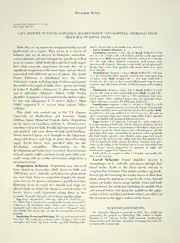
Life history of Pontia daplidice moorei (Rober) (Lepidoptera: Pieridae) from Himachal Pradesh, India PDF
Preview Life history of Pontia daplidice moorei (Rober) (Lepidoptera: Pieridae) from Himachal Pradesh, India
General Notes JournaloftheLepidopterists'Sock-It/ 59(3),2005, 170-171 LIFE HISTORYOFPONTIA DAPLIDICE MOOREI (RoBER) (LEPIDOPTERA PIERIDAE) FROM : HIMACHAL PRADESH, INDIA Butterfliesare animportantcomponentoftheoverall about 1.2hoursandoccursmainlyin thei "g- biodiversity of a region. They occur in a variety of Larva: Numberofinstars:4 First instar(duration = 2days. Fig.2). Head: Width0.34 ±0.02 choanbsiteartvsatiaonndistasreanodfeinnttoemroelstogitsotsbifoolrogsipsetcsi,fincatausrwaelilsltsa,s pmrmima(rny=set2a6e.);Bobldayc;k,Lweintghthwe2l.l05de±f0i.n0e4d,mgml,obwuildatrhoc0e.l3l6i,±a0n.d04smmalml general reasons. Adult butterflies and their early stages (n = 26); pale yellow, distinctly segmented, small primary setae presenton all segments; alimentarycanalvisible as darkgreen mid- have dual economic importance because they are a dorsal stripe; entire body speckled with minute black dots, more significantcomponentof the foodchain, andare closely denselaterally. associated with different species of plants. The genus Secondinstar(duration = 2days). Head:Width0.70 ± 0.02mm (n = 22); brownish-yellow, sparsely covered with moderately long Pontia Fabricius is distributed over the entire secondary setae. Body: Length 4.46 ± 0.07 mm; width 0.83 ± Palaearctic region, including most ofAfrica, and enters 0.03mm(n=22 );sameasaboveexceptwithgreenish tingebetween thenorth-westernpartofIndia. Threespecies arefound segments,andwithmixtureofwhiteandblack,primaryandsecondary setae. in India: P. daplidice (Linnaeus), P. glauconome Klug Thirdinstar(duration=3days),Fig.3).Head:Width1.73±0.05 and P. chloridice (Hiibner) (Talbot, 1939). Pontia mm (n=20);sameasabove exceptlightgreen.Body: Lengdi8.30± daplidice (Linnaeus) is representedinthe Indian region 0.12 mm; width 1.64 ± 0.17 mm (n = 20); mid-dorsal stripe gray; dorsal stripes yellow; subdorsal stripes gray; and spiracular stripes by only one subspecies, P. d. moorei (Rober). Mani yellow.Allstripesextendfordiefulllengthofthebody. (1962) reported P. d. moorei from Lahaul Valley mmFourthinstar(duration =4days,n=20,Fig.4).Width2.4±0.05 (4300m). (n = 20);creamish,sparselycoveredwithmixtureofmoderately longwhiteandblacksetae;andwithtwolateralyellowpatches.Body: This study was carried out at Dr. Y.S. Parmar Length23.0 ± 0.47 mm;width3.3?? ±??0.12mm (n = 20);sameas University of Horticulture and Forestry, Nauni above exceptgraystripes nowbroaderthanyellowstripes; spiracles (1440m), Solan, Himachal Pradesh, India. Oviposition whitesurroundedwithprominentlightgreenborder. Pupa(duration = 6-7days, Fig.5) Length 18± 1mm;width4.2 ± on the leaves of Lepidium ruderale L. (Brassicaceae) 0.13mm;taperingatbothends,withtheanteriorenddrawnouttoa wasobservedinthe field. Freshlylaideggswerelocated spine likepoint; abdominal segmentation well defined; stripes as in and marked, and were observed daily until hatching. 4th instar except the dorsal stripes now yellowish-green, and the spiracularyellowstripeextendsfromtheposteriorendtoapointhalf Newly hatched larvae were brought to the laboratory the body length; spiracles white distinct; entire pupa held closely along with leaves, and kept in petri dishes/breeding appressedtodiestemortotheceilingofthebreedingchamber,bya cages. Fresh leaves were provided daily for the well developed silk girdle around the thorax. Pupation took place eitherontheceilingofthebreedingcageoronthestemofthehost developing caterpillars. Observations on the plant. Larvae began preparation for pupation at night, and development and habitswere recorded. Measurements transformedtopupae10tol4hourslater. of head capsulewidth, andbodylength andwidthwere Adult eclosion is completedwithin 1.5-2 hours, and usually take placeinthemorning. made using with an ocular micrometer adapted to a Larval behavior: Pontia daplidice moorei is stereomicroscope. monophagus on L. ruderale, and passes through four Oviposition behavior: Oviposition was observed larval stadia. Each of the three larval ecdyses is from March to September 2002, between 1000 and completedin5-9hours. Firstinstarseattheireggshells, 1600 hours, on L. ntderale, an herbaceous plant about then begin skeletonizingthe tender leaves oftheir host one foot high. Prior to opposition females fly slowly, plant, eatingthe leaftissue except fortheveins. Second quiteclosetotheground, andspendagooddealoftime instars eat tenderleaves except midrib. Third and forth fluttering about in search of a suitable leaf. Eggs are instars devourthewhole leafincludingthe midrib. First placed singly on either the dorsal orventral surface of and second instars rest along the midrib on the upper tender leaves, each deposition taking three to five surface ofleaf, and third and forth instars rest eitheron secEogngds(.FigF.le)m:aHleiegshtth0.e8n7f±ly0.o0f3fmtmo,lowicdatthe0a.n34ot±h0e.r02plmamnt.(n = the stems oron the uppersurface ofthe leaves. 28);bottleshaped,upright,basecomparativelybroaderandrounded; sculptured with prominent ridges, furrows and transverse striae; ACKNOWLEDGEMENTS mieropyler end narrow with small circular disc; ??shinning??white whahtecnhinfgr.eshlylaid, orangeafteroneday,thenturningblackishbefore Dr. Narender Sharma is grateful to DST, New Delhi for fmoiuerIrnodpcayuylbsea.rtiTeohnnedPoyeforutinhoegdelagangr,dvatHheaemtnecrhegiaentssg:tahTfetheeergegcghgsehwielinlcn.ugbHaaattichoohnliepnegriintoadtkheises TtesrhxpoaoapnnmiksicfonaurillinngRtgeotshteeDharemr.acpnhArunosInjcneersctittipttteuo.tneA,ieBlRuletopt,eurbfSlltiiaecfsf.ofSTcPiheaenntiaasmtu,tahoSformriticshrishtoiincgiahlallnyy Volume 59, Number 3 171 Figures 1-5. Pontiadaplklicemoorei. 1. Egg(ca.50x). 2. Firstinstar(ca.40x). 3. Thirdinstar(ca. llx). 4. Finalinstar,headand bodydetails(ca. 12x). 5. Pupa(ca.3x). Literature Cited Narender Sharma, Zoological Survey ofIndia, M- MANI, M.S. 1962. Introduction to high altitude Entomology. Block, NeiCAlipore, Kolkata-700 053 INDIA Methuenand Co. Ltd., London,302pp. Talbot, G. 1939. The FaunaofBritish IndiaincludingCeylon and Burma. Butterflies ??volume-2. Taylor and Francis, London, 506pp.
